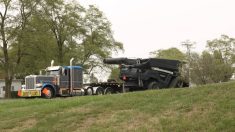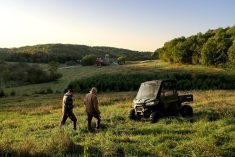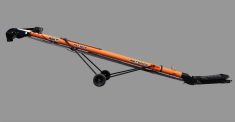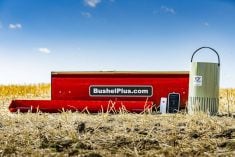This will be huge for us,” said a friend who is a salesman at a local John Deere dealership. We were talking about the all-new R4030 and R4038 sprayers Deere introduced at its product launch in Columbus in August. “They’ll sell out within a couple of days of starting to accept orders,” he added confidently.
Brea Harms, John Deere’s product line manger for application equipment, shared his confidence in the new sprayers during a media briefing at the Columbus, Ohio, event. “What you’re going to say is ‘holy cow, you’ve changed those machines,’” she told a group of editors at the product launch. “It’s the first major redesign we’ve had for sprayers in 15 years, since we introduced the 4700 sprayer. We’ve redesigned these sprayers from the ground up. And we’ve redesigned the solution system from tank to tip.”
Read Also

Claas brings 1000 Series SP forage harvesters to Canada
In mid-August, Claas unveiled its new line of Jaguar forage harvesters at an event in Visalia, California, deep in the heart of that state’s dairy region.
The two new models find their place in the middle of the brand’s sprayer lineup, between the existing 4630, which is the smallest model in the line, and the flagship 4940. “We are going to continue forward with four models of sprayers, but we are replacing two this year,” she said. “The 4730 will be replaced with the R4030 and the 4830 will be replaced by the R4038.”
If those new model numbers sound a little familiar, they should. The “R” indicates the specifications level, similar to how it’s used on tractors. And the 4000 Series becomes just the 4 Series. Deere wanted to stick with the four in the model numbers because the existing sprayer line has been pretty popular with farmers. “We did a lot of studies as we were trying to figure out our name and numbering,” explained Harms. “There’s a lot of brand equity in the 4000 Series sprayers, so we chose to keep the 4.”
The 30 and 38 in the numbers represents the tank size divided by 100. So the R4030 has a 3000 litre tank (800 gallons) and R4038 has a 3,800 litre (1,000 gallons) capacity.
The design
The two new models join the 4940 in offering integrated direct chemical injection systems to make blending tank mixes much easier. “Customers, in some cases, can just run water in the solution tank,” said Harms.
“As we designed the R4030 and R4038, we tried to think of ways to help our customers overcome the challenges of glyphosate resistance and really focus on trying to drive efficiency in sprayer operation,” she said. “One of the key ways we’re able to do that is with integrated direct injection.”
Raw chemical placed in either of two 50-gallon tank injection tanks flows through the same pump, while the contents of an additional, 35-gallon injection tank flows through another lower-volume pump, so spraying tank mixes becomes a much simpler process. Mixing rates can be controlled through the GreenStar 2630 in-cab display monitor. “We’ve partnered with Raven,” said Harms. “It’s totally integrated in the 2630 display. “You can calibrate it very easily.”
That minimizes time spent on tank clean outs while making chemical change-overs faster and easier. It also helps prevent wasting chemicals.
The pumping systems on the new models have been beefed up to allow chemical flow to keep up with higher field speeds. To help understand how much, the new standard-flow pump now exceeds the capacity of the high-flow option on existing models.
“For that customer that knows he wants to apply high-rate liquid fertilizer, if he invests in an R4038 with the high-flow solution pump and high-flow plumbing he can go 18 miles an hour,” noted Harms.
Overall, maximum working speeds have been bumped up significantly. Under the right conditions, the R4030 can operate at up to 20 m.p.h. In the field, and the R4038 can hit 25 m.p.h.
Behind the tanks, a newly-redesigned plumbing system simplifies the piping system while eliminating low spots that can trap air or hold chemical. Both models can be fitted with 120-foot flat-fold booms that feature swing link suspension and tri-direction break away for protection. The number of boom sections that can be shut off independently has been increased to minimize overlap when spraying.
To power the two sprayers, the R4030 gets a 6.8-litre PowerTech PSS Tier 4 Final-compliant diesel that puts out 280 horsepower. Its bigger brother gets a 9.0-litre engine, capable of putting 310 horses through to the four-wheel hydrostatic drive.
And like all of Deere’s new machines, there is an upgraded, more comfortable cab to make the work day a little more pleasant for operators.
“It (the new sprayers) is a pretty big deal for us,” said Harms. “It’s something our customers have been asking for.”















